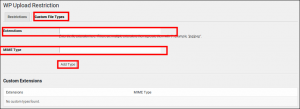
Eddie is a content marketer and a Seo strategist Essay Help UK
Do you own a membership website or forum? Then you must take steps to restrict file uploading permission in WordPress. In fact, all users whether converting HTML CSS to WordPress or acquiring new interfaces must exercise control over the feature. Any website which allows visitors to upload items must have a regulatory system in place. This will prevent people from uploading unnecessary or bulky elements which may harm the interface. Large size items can cause the page loading speed to drop down and have a bad impact on the user experience. In this tutorial, a simple method to restrict the uploading permissions is being provided for WordPress website owners. However, before discussing the process it will be pertinent to know about the file permissions system of the CMS.
Understanding WordPress File Permissions
In WordPress, there are three kinds of permissions that can be granted to three types of users. The first kind of user is called user or owner. It is generally the website owner who is specified in this category. The second type is the group which can be a set of people chosen to perform specific functions. The website owner is usually a part of the group. Finally, the last type of user set is called the world. It comprises of all the visitors to the website.
You can specify three kinds of permissions to all the users:
- Read: Only allowed to view or read a file. No alterations can be made to the file.
- Write: Permitted to modify a file.
iii. Execute: Allowed to execute i.e read, write, modify or delete the file.
Each permission has been assigned specific values which are as follows:
- Read: 4
- Write: 2
iii. Execute: 1
These values are used to compute the permission mode. For instance,
User: r+w+x = 4+2+1 = 7
Group: r = 4+0+0 = 4
World: r = 4+0+0 = 4
744
This means that the user has rwx (7) permission to read, write, and execute the file. The group and others are only allowed to read the file. Simply taking a look at the string, 744 will help you understand the permission mode.
Permissions vary from one hosting service to another. However, the user account on the website server must be the owner of all files. Files requiring to write access from WordPress must be owned by the user. In case they are owned by a group, the user must be a part of the group. All core files must be writable only by the user account.
How To Moderate Uploading Permissions For Files In WordPress
We will now explain the method to restrict file uploading permission in WordPress. It is a simple process that even non-technical users can perform easily.
1. Install The WP Upload Restriction Plugin
Plugins are one of the most advantageous features of the open source platform. You can add functionality or a desired feature to your interface simply by integrating a relevant plugin. Assimilating these tools into your website is not a difficult task. In this tutorial, we will use the WP Upload Restriction plugin to moderate the permissions. First, enter your username and password to access the admin dashboard of your WordPress installation. Now, select “Plugins” in the menu on the left-hand side and go to “Add new”. Type the name of the plugin in the search field. Locate the correct tool in the result and click to download and install it. Activate the tool and move to the next step.
2. Define The Restriction Settings
WP Upload Restriction will now be visible in the plugins section of the menu. Click on it and go to its settings page. Select the “Restrictions” tab. Here you will find an extensive list of file types. You can tick the boxes against the types which you want to permit for uploading.

You can also define specific file formats. Select the “Custom File Types” tab and enter the desired type in the “Extensions” field. Enter the MIME Type and then press the button called Add Type.

Scroll down until you reach the Allowed Upload Size section. Tick the box and define a value to restrict the upload file size. Save the changes to complete the process.

Conclusion
You will now be able to restrict file uploading permission in WordPress websites. This simple process will let you control the uploads on your interface and provide a satisfying experience to visitors.
About the Author:
Brandon Graves is a WordPress developer by profession and He works for a leading Site to WordPress services provider company – HireWPGeeks Ltd. He uses to write useful tutorials on WordPress and socialize its different social media platforms.
Eddie is a content marketer and a Seo strategist Essay Writers.










